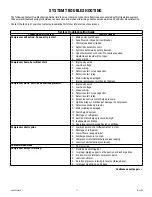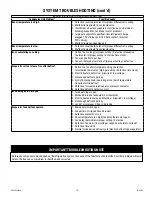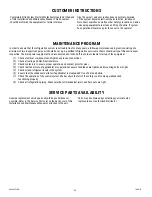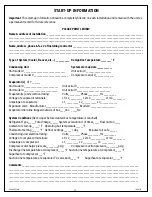
K90-KPCS-IM-2
18/04/22
- 15 -
CHECKING SUPERHEAT
To obtain maximum system capacity and insure trouble free operation it is necessary to check both the compressor and evaporator
superheat.
IMPORTANT SYSTEM BALANCING NOTE
Compressor suction superheat must be checked. To check the superheat at the compressor the following steps should be followed:
(1) Measure the suction pressure at the suction service valve of the compressor. Determine the saturated
temperature corresponding to this pressure from a “Pressure- Temperature” chart.
(2) Measure the suction temperature of the suction line about 6 inches
(15 cm)
back from the compressor suction
valve using an accurate thermometer.
(3) Subtract the saturated temperature (from step 1) from the actual suction line temperature (from step 2). This
difference is the
actual superheat at the compressor.
System capacity decreases as the suction superheat increases. For maximum system capacity, the suction superheat should be kept
as low as is practical. The superheat at the compressor should range within 20 to 45 °F
(11.2 to 25.2 °C)
Superheat.
NOTE
: Too low of a suction superheat can result in liquid being returned to the compressor. This can cause dilution of the oil and
eventually cause failure of the bearings and rings through wash out as well as liquid slugging.
NOTE
: Too high of a suction superheat will cause excessive discharge temperatures which cause a break down of the oil and will result
in piston ring wear, piston and cylinder wall damage.
If adjustment to the suction superheat is required, it should be done either by adjusting the thermostatic expansion valve at the
evaporator, the use of liquid to suction heat exchanger or suitable use of suction line insulation.
Compressor Superheat
Once the refrigerated space is at its design temperature or close to design temperature, the evaporator superheat must be checked. To
check the suction superheat at the evaporator the following steps should be followed:
(1) Measure the suction pressure in the suction line at the bulb location by either,
(a) A gauge in the external equalizer line will indicate the pressure directly and accurately.
(b) A gauge directly in the suction line near the evaporator or directly in the suction header will suffice.
(2) Measure the temperature of the suction line at the point where the thermostatic expansion valve bulb is
clamped to the suction line.
(3) Convert the pressure obtained in step 1 above to a saturated evaporator temperature from a “Pressure-
Temperature” chart.
(4) Subtract the saturated temperature (from step 1) from the actual suction line temperature (from step 2). This
difference is the
actual superheat at the evaporator
.
The superheat at the evaporator should be a minimum of 6 to 10 °F
(3.4 to 5.6 °C)
for systems with a 10 °F
(5.6 °C)
design TD
(temperature difference) to a maximum of 12 to 15 °F
(6.7 to 8.4 °C)
for systems with a higher operating TD.
Low temperature applications (freezers) should be set at superheats of 4 to 6 °F
(2.2 to 3.4 °C)
.
TD = Box temperature – evaporating temperature.
Evaporator Superheat










































